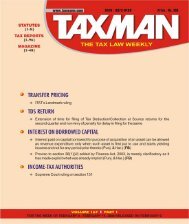CPT V24P7-Art1 (Content).pmd - Taxmann
CPT V24P7-Art1 (Content).pmd - Taxmann
CPT V24P7-Art1 (Content).pmd - Taxmann
You also want an ePaper? Increase the reach of your titles
YUMPU automatically turns print PDFs into web optimized ePapers that Google loves.
ent free accommodation was not being added<br />
in the income of the assessee due to<br />
reimbursement of rent to employer, the same<br />
reimbursement could not be treated as payment<br />
of rent to the employer for the purpose of<br />
working out exemption for HRA under section<br />
10(13A) of the Income-tax Act, 1961.<br />
Capital gains from sale of ‘multiple houses’<br />
can be invested in new house for section<br />
54 deduction<br />
In Dy. CIT v. Ranjit Vithaldas [2012] 23<br />
taxmann.com 226 (Mumbai - Trib.), the Tribunal<br />
took up the issue as to whether capital gain<br />
from sale of ‘multiple houses’ can be invested<br />
in new house to claim section 54 deduction.<br />
In this regard, the Tribunal held as follows:<br />
(a) There is an inbuilt restriction that capital<br />
gains exemption under section 54 is available<br />
only in respect of investment in one<br />
house;<br />
(b) However, this provision does not restrict<br />
the exemption if capital gain arising from<br />
sale of more than one house property is<br />
invested to purchase or to construct a<br />
new house;<br />
(c) Therefore, even if assessee sells more than<br />
one house in a year and capital gains<br />
arising on sale of multiple houses are reinvested<br />
in a new residential house; the<br />
exemption under section 54 cannot be<br />
denied, subject to fulfilment of other<br />
conditions; and<br />
Further, even if two flats are sold in different<br />
years and capital gains from both flats are<br />
invested in one residential house, exemption<br />
under section 54 will be available in respect<br />
of capital gain accrued from sale of each flat<br />
provided the time-limit for construction or<br />
purchase of new house is satisfied in case of<br />
each flat sold.<br />
}<br />
}<br />
Section 54F exemption to be denied<br />
only if multiple houses are under ‘exclusive<br />
ownership’ of assessee<br />
In Dr. (Smt.) P. K. Vasanthi Rangarajan v.<br />
CIT [2012] 23 taxmann.com 299 (Madras), the<br />
assessee, owned a property along with her<br />
husband which is used as a clinic at the ground<br />
floor and for the purpose of residence at the<br />
first floor. The assessee entered into a<br />
development agreement for the joint development<br />
of 8 apartments in another property owned by<br />
the assessee. The development agreement<br />
provided for retaining undivided share of 50%<br />
by the assessee and the remaining in favour<br />
of the developer. In addition, the developer<br />
had to construct on the land entrusted to them,<br />
a new building consisting residential apartments<br />
and give the assessee 4 residential apartments<br />
and ` 10 lakhs in exchange for the undivided<br />
share of land in favour of developer. The<br />
undivided share was sold by assessee. The AO<br />
rejected the claim of the assessee with regard<br />
to exemption under section 54F on the ground<br />
that if more than one residential house was<br />
owned by the assessee on the date of transfer,<br />
exemption under section 54F was not allowable.<br />
On appeal, CIT(A) upheld the order of AO.<br />
On further appeal, the Tribunal also rejected<br />
the claim of the assessee under section 54F<br />
stating that although the assessee was the owner<br />
of 50% and not 100% of the property, the<br />
conditions of section 54F were not fully satisfied.<br />
The High Court held in favour of assessee -<br />
It was held that second proviso disentitled the<br />
exemption contained in the parent provision<br />
only when the assessee had the exclusive<br />
ownership of a residential house as on the date<br />
of transfer of the asset which was not there in<br />
the case of assessee as she owned only 50%<br />
share in the property. Therefore, on an analysis<br />
of section 54F and its proviso it can be concluded<br />
that exemption can be denied where the assessee<br />
owns a residential house as an exclusive owner<br />
and not in the case of a joint ownership. Therefore,<br />
deduction was allowed to the assessee.<br />
August 1 to 15, 2012 u TAXMANN’S CORPORATE PROFESSIONALS TODAY u Vol. 24 u 67<br />
}<br />
687











![“FORM NO. 3CEB [See rule 10E] Report from an ... - Taxmann](https://img.yumpu.com/45480232/1/190x245/form-no-3ceb-see-rule-10e-report-from-an-taxmann.jpg?quality=85)





